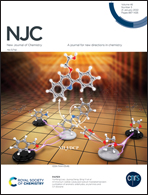‘Hybrid’ mero-anionic polymethines with a 1,3,2-dioxaborine core†
Abstract
The synthesis and spectral properties of vinylogous series of novel mero-anionic polymethines of the D–π–A–π–A′ type are reported. Based on their electronic structures, these dyes can be regarded as a superimposed ‘hybrid’ of a merocyanine (D–π–A) and an anionic polymethine (A–π–A′). The obtained mero-anionic dyes comprise the difluoroboron β-diketonate ring (A) as a part of their π-chain, the 1-alkyl-3,3-dimethylindole moiety as the electron-donor end-group (D), and the moieties of CH-acids of varying strength (malononitrile, (thio-)barbituric acids, etc.) as the electron-acceptor end-group A′. Depending on the A′ structure and the π-chain length, the long-wavelength absorption maximum of the studied mero-anionic dyes varies in a range of 594–777 nm, with a bathochromic shift of 64–89 nm per vinylene group and a molar absorbance of up to 337 000 M−1 cm−1. The obtained dyes demonstrate a minor positive solvatochromism in the solvent pair dichloromethane–DMF; when methanol is used as the solvent, a hypsochromic shift of the absorption maximum is observed. The fluorescence quantum yields of the novel fluorophores reach a value of up to 84% for the dyes absorbing in the visible spectral range and up to 49% for some of the longer-chained NIR absorbing mero-anionic polymethines.



 Please wait while we load your content...
Please wait while we load your content...